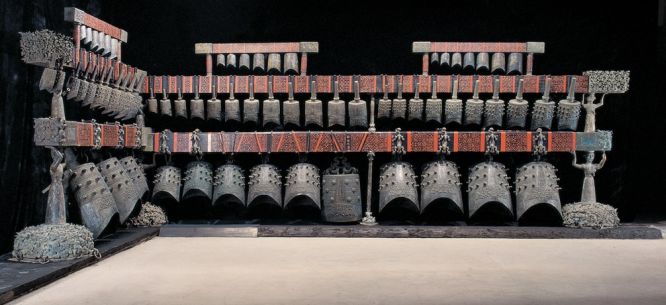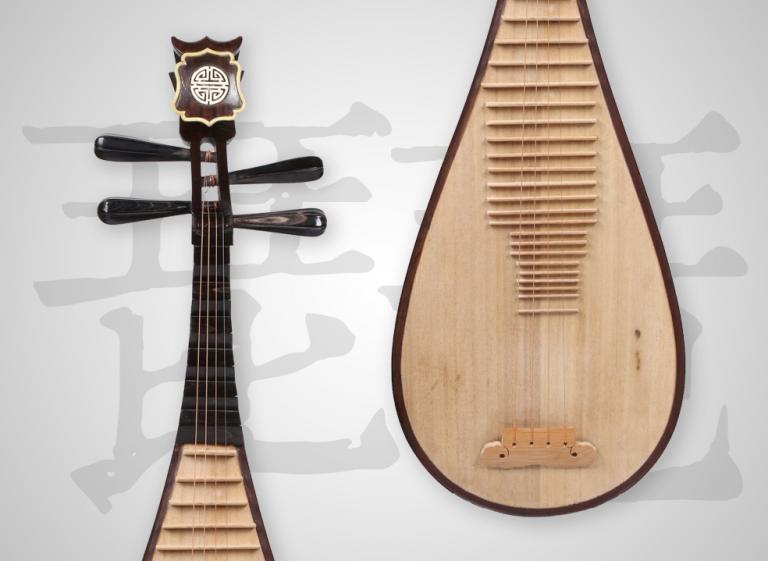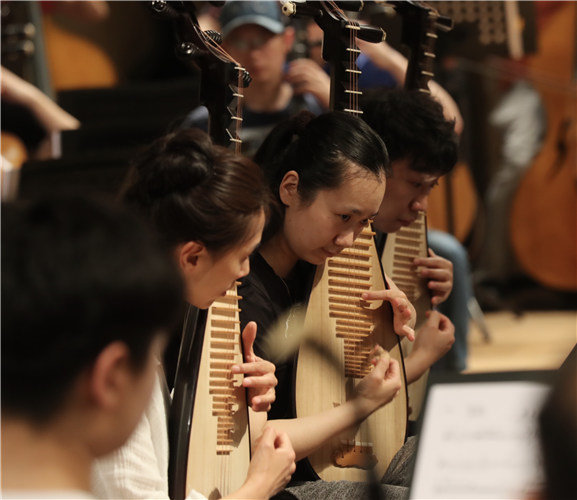Representatives of Folk Musical Instruments
10 min readZeng Houyi Bells-Gem of Ancient Chinese Art
The set of bells, set of chimes and other instruments excavated from the tomb of Zeng Houyi,a Warring states duke, are the largest-scale ancient percussion instruments found so far.
The Zeng Houyi bells are a three-tiered set which has 65 refined bronze bells. There were inscription of seal characters and his name on each bell.
The musical range of the Zeng Houyi bells, which can carry the main melody as well as the harmony, was five octaves, next only to modern piano. Modern scholars inferred that the set of bells could not only play melody, but also play in a musical ensemble.
All the musical instruments excavated from the Zeng Houyi tomb show superb craftsmanship and function surprisingly well. The bells has established itself as one of the wonders of traditional Chinese music.

Zhuihu-an Instrument That Can Speak and Sing
Zhuihu,a bowed string instrument, also known as Zhuiqin or Zhuizi, is altered from sanxian(a three-stringed musical instrument), can be used to perform solo and tutti. Since Zhuihu has a wide diapason,a soft sound and relatively high sound volume, performers can use it to imitate the voice of human and animals.
There is a legend about the origin of Zhuihu. In the Qing Dynasty, Emperor Kangxi forbad all the opera performances in the Forbidden City and artists had to earn a living on the street.
One day, an artist’s sanxian was bitten by mice and the covering leather of the sound box gotahole in it. In order not to miss the performance, the artist had to use piece of paulownia wood to replace the leather and used a bow from huqin(two-stringed Chinese violin) to play the sanxian. This musical instrument that could not only play music but also imitate human voice, was later called Zhuihu.
Bone Flute-Earliest Musical Instrument of China
There are various kinds of musical instruments in the world, including Chinese musicalinstruments, western musical instruments, special instruments, wind instruments, stringed instruments and so on. Among them, the earliest musical instrument is bone flute. However, in the 1980s, China did discover bone flutes of 8,000 to 9,000 years old.
Excavations in 1986 and 1987 at the early Neolithic site of Jiahu Village, Wuyang County, located in central Henan Province, China, have yielded 6 complete bone flutes. Fragments of approximately 30 other flutes were also discovered. Three seven-hole dizi are now keptin Beijing Musemu, Henan Musemu and Henan Institute of Cultural Relics. The flutes may be the earliest complete, playable, tightly-dated, multi-note musical instruments.
Liuqin-Small Version of Pipa
Liuqin, with four strings which sound similar to mandolin, is played with a piece of plectrum, and is used to accompany other instruments for folk songs and local opera.
The liuyeqin, abbreviated to the liuqin, has got its name from the willow-leaf-sharped sound box. It is also called tu pipa(unrefined pipa) because of its appearance of a small pipa. It came into use in the music of the local operas, narrative singing(storytelling music) in north Jiangsu, south Shandong and Anhui provinces.
The folk type is made of willow wood, with 2 or 3 strings and 7 frets. The performer plays it with a slender bamboo tube on the forefinger as a plectrum. The professional type is made of red sandalwood or rosewood, and the performer plays it with a plastic pick(the same as guitar pick). In the modern type the front sides made of paulownia wood and the reverse side, ofred sandal. The four strings are steel wires. The frets, increased from 7 to as many as 24, are arranged in half-step intervals. The plectrum is made of horn. The tone quality is clear, bright and more delicate.

Qing-Oldest Percussion Instrument
Qing (musical stone) was a kind of stone or jade percussion instrument in ancient China. It was hung on shelf and played with wooden hammer. It was not only a kind of musical instrument, but also the symbol of power and status.
Historical records show that qing originated from stone tools used in daily life by Chinese ancestors. During their laboring, they found that these tools could produce pleasant sounds and therefore used them as musical instruments for entertainment.
Archeological findings show that qing came into being in the Xia Dynasty 4,300 years ago. By the Zhou Dynasty,a set of qing, pending from a rack and each with a different tone, emerged and these qing series were a native Chinese invention. The whole rack is called Bianging.
Erhu-Queen of Chinese Folk Orchestra
Producing one of the most beautiful and haunting sounds in Chinese music, the erhu is one of the most popular Chinese bowed-string instruments with a history of more than 1,000 years.
Hailed as a Chinese violin, the erhu is quite different from a western fiddle. There is a vertical post with a fingerboard crosses the sides of a resonator at its base. This resonator, made of either wood or bamboo, is covered with a piece of stretched python skin. The erhu bow is placed between its two strings called the inner and outer strings. Traditionally the two stringsare made of silk, but metallic strings are more popular now. An erhu player usually sits with theinstrument on his or her left upper thigh in front of the left hip. The erhu is played by moving the bow horizontally over the two vertical strings, with sound produced by the vibration of the strings.
The range of erhu spans over three octaves and the tune produced shares some qualities with the violin, although it produces a more nasal tone which is gentle but firm. The erhu resembles a human voice and can imitate many natural sounds, such as birds and horses. It is a very expressive instrument, most known for playing melancholy tunes, but also for its joyful melodies.
The erhu is almost always a must in national orchestras. In fact, the erhu plays the same role as the violin in Western orchestras. The erhu is extremely popular in China today asa medium for both traditional and contemporary music and plays an important role in both solo and orchestral performances.

Dizi-Bamboo Flute
Diziis native to China with a very long history. It became popular as early as the Warring States Period. Two flute instruments were discovered in the relics excavated in Tomb No.3 of Mawangdui in Changsha, Hunan Province.
This transverse bamboo flute has a blowing hole,a stop hole and six finger holes. Bamboo can be found in many places in China and it is very easy to make a bamboo flute. Therefore, bamboo flute is a very popular musical instrument in the country.
There are two basic kinds of dizi-bangdi and qudi. Bangdi, popular in northern China, got its name because it is used to accompany clapper-type operas. It is 40 centimeters long and has a strong and piping tone, suitable for expressing robust and lively emotions. Qudi, popularin southern China, is also named as sudi for its origin from Suzhou city. It is often used toaccompany Kunqu Opera. Sudi is about 70 centimeters long and its tone is pure and mellow, making it suitable for expressing delicate and understated moods.
A large number of techniques are used when playing these wind instruments, such as tapping, tremolo, legato, flower tongue, augment, glide, trill, overtone. Famous dizitunes include Joyous Meeting, The Partridge Soars, The Bird in the Shade, Five Clappers and A Tripto Suzhou.
Guqin-Representative Instrument of Chinese Music Culture Guqin is also called the seven-stringed qin. The body is a long and narrow sound box made of wood. Generally speaking, it is 130 centimeter long,20 centimeter wide and about 5 centimeter thick.The surface is generally made of paulownia wood or China fir,and has seven strings stretched along it.Black is the common color for guqin.Sometimes brown or red ones can also be seen.On the edges are 13 inlaid jade/gold markers.Catalpa woodis used for the base,and there are two holes,one big and one small(called the”phoenix pool”and”dragon pond”,respectively)to emit the sound.
Because it embodied the traditional cultural values of clarity,fineness,simplicity and far-sightedness,gugin,along with chess,calligraphy and painting,headed the list of four subjects scholars trained themselves in.Throughout history,philosophers and artists suchas Confucius,Cai Yong and Ji Kang were all masters of the instrument.Old records contain a large number of treatises on guqin,and thousands of pieces of music for this instrument have been preserved.
In recent times,a dozen or so masters of gugin have emerged in China.They have mastered the strong points of the various schools of this instrument and grasped the interpretation ofa large number of pieces of gugin music,manifesting not only their musical skill but also their deep esthetic appreciation.
Konghou-Chinese Harp
Konghou ,also called Kanhou,is an ancient plucked stringed instrument in China.There are mainly three kinds of konghou:one is played lying flat,one is played upright and another one is the phoenix-headed konghou.As early as the Spring and Autumn and Warring States period,there appeared the rudiment of konghou played lying flat in the Chu Kingdom in southern China.Konghou was originally used in Yayue(court music),and was used in Qingshangyue(a music genre)in the Han Dynasty.It was used in Yanyue(music played in court banquets)in the Sui Dynasty,and gradually prevailed among the ordinary people and in places inhabited by ethnic minorities.
Konghou played upright appeared in the Eastern Han Dynasty and got popular in the Suiand Tang Dynasties. It was generally played in rites and ceremonies. The phoenix-headed Konghou was introduced from India to the Central Plains of China in the Eastern Jin Dynasty, and was prevalent in the Sui and Tang Dynasties.
Konghou, with its sweet timbre and wide diapason, can be used to play not only cantus but also chord and has many advantages in both solo and tutti performances. It was an indispensable instrument in China’s ancient royal courts. From basso-relievo in the Yungang Grottoes of Datong and Dunhuang murals we can see persons playing Konghou. This shows that Konghou playing was very popular in China a long time ago.
Pipa-an Expressive Instrument
The earliest form of pipa known appeared in the Qin Dynasty. It had a long neck, leather surface and circular sound box, and was held upright. Around the time the Qin was succeeded by the Han Dynasty, this instrument underwent a number of modifications and it evolved into the ruan, three-string(sanxian), yueqin, etc. All these forms of the pipa had the common characteristics of a straight neck and circular sound box.
Two major changes which took place in the course of its evolution were the practice of holding the instrument upright instead of horizontally while playing it and the use of 5 fingers to pluck the strings, instead of using a plectrum. The long-time history endowed pipa a rich collection of scores and a mature performing technique. In the 20th century, through the unremitting efforts of a large number of performing artists and composers, the amount of techniques and compositions developed quickly, with the result that the pipa is now one of China’s most important national instruments for solo, accompaniment and ensemble recital.
Harvest Drum-A Special Instrument
Harvest drum, or peace drum, is popular among regions of Northeast China, Inner Mongolia, Hebeiand Anhui provinces. It’s a kind of feature instrument used mainly by the Han and Manchu people. It is said that the drum came into being in the Tang Dynasty and was named as harvest drum in the Ming Dynasty.
According to folk legends, the harvest drum was a tool used by Manchu hunters. Hunters were beating drums when they pursued an animal. And they kept beating drums to express their pleasure when they got back with their preys.
Harvest drums have many different features. Those used by Manchu are oval-shaped. The ones used by Han people are round, oblate or peach-shaped. The drum in Mongolia is onlyoblate-shaped. People like dancing accompanied by harvest drum playing, especially when they celebrate festivals.
Xun-One of the Oldest Music Instrument in China
The only earthen musical instrument is a kind of ocarina called xun, which was a very important wind instrument in ancient China. It can produce sound with a timbre similar to that of human voice, and is suitable for performing some lamenting aria.
People in ancient times used the instrument to imitate bird sounds and ensnare them.
The oldest xun that has been discovered in China up to now was made about six thousand years ago. For instance,a conical xun was discovered in the Hemudu of the Hangzhou Bay in Zhejiang Province. The xun without holes and the one-hole xun were found in the Yangshao Culture site in Banpo Village in Xian and xun was also discovered in Wanrong County of Shanxi Province, Yumen Huoshao Gou of Gansu Province and Huixian County in Henan Province.
Yangqin-Adapted from a Foreign Instrument
Yangqin(see picture 17-10), the strike-stringed music instrument, was originated from west Asia and introduced to Europe in the 11th century.It was said to have been introduced to China from Europe in late Ming Dynasty.It has been combined into Chinese national music for more than 300 years and has become an important folk musical instrument.
To improve the traditional yangqin,Chinese musicians have tried very hard to make changes on its music scales,increase its harmony,augment its loudness and deepness,and improve its timbre.Moreover,many professional performing techniques have been developed to lift up on its expressions.Thus the instrument has been a dominant character in a modern Chinese ensemble as well as a powerful solo instrument for performing Chinese national pieces.








